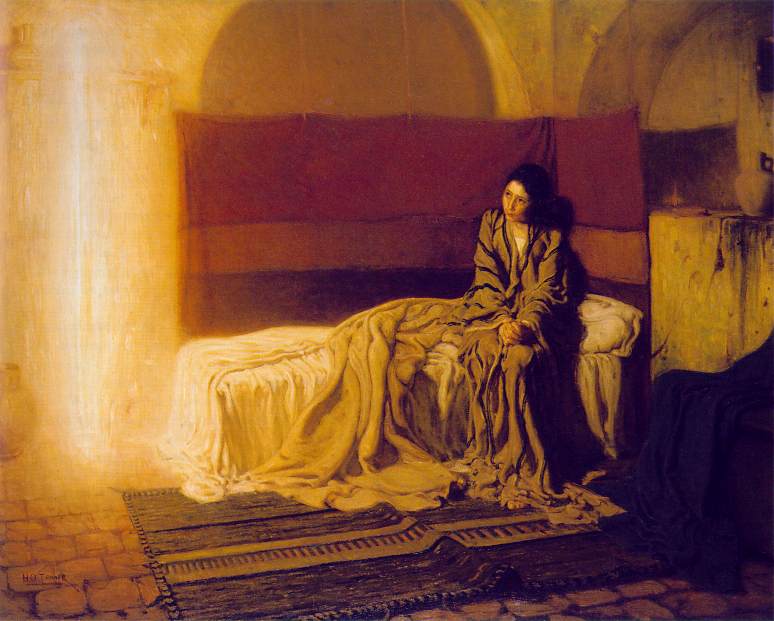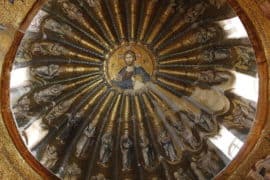As we begin to reconstruct the birth, life, and teachings of Jesus our best and earliest sources are the four gospels, Matthew, Mark, Luke, and John, contained in the New Testament. For the past two hundred years scholars have analyzed and compared these texts and their relationship to one another. The results of this painstaking research have allowed us to read them more carefully, and to use them responsibly as we do other ancient historical sources, even though they are included in the New Testament canon as sacred texts of scripture. I often hear the erroneous charge that a critical reading of our gospels sources involves a mere “picking and choosing,” arbitrarily, of what the investigator wishes to keep and what he or she wishes to throw out. This is hardly the case. There is a method involved and all of us who work as critical historians are obligated to make clear how we go about doing our work. See my essay, “Picking and Choosing: How Scholars Read the Gospels,” for more on this point.
All four New Testament gospels are written in Greek though we have an ancient tradition that the gospel of Matthew was originally composed in Hebrew or Aramaic. The names associated with these gospels are traditional and the authors, whoever they might have been, never identify themselves by name. Mark is our earliest gospel, even though it comes second in the New Testament. Mark was written around 70 AD, and it provides us with the basic narrative framework of the career of Jesus. Matthew was written next, likely around 80 AD, and the author uses Mark as his main source but edits it freely, as we will see. The author of Matthew also had access to a collection of the teachings of Jesus that we call Q, which Mark did not have. He incorporates that material into his work as well. Luke was written around 90 AD and the author uses both Mark and the Q source, but he has a considerable amount of his own material with which he supplements his story. These three gospels, Mark, Matthew, and Luke, are called the Synoptics, because of the tight literary relationship between them. One simple way of putting this is that Mark provides the basic story line, and both Matthew and Luke use Mark but incorporate Q and some of their own materials. John is our latest gospel, written toward the close of the 1st century, and it has no literary connection to the three Synoptic gospels. The author of John offers us an entirely independent tradition focusing on Jesus as a divine and exalted Son of God. In that sense John is more theologically oriented but that is not to say his account is devoid of valuable historical information. As we shall see, without John’s independent record there are many important geographical and chronological details we would lack.
There are other gospels than these four, such as the Gospel of Thomas, written in Coptic, that was discovered in 1945 in Egypt, a Hebrew version of Matthew passed down within rabbinic circles, and a half-dozen so-called “Apocryphal” gospels, that were composed in the 2nd and 3rd centuries AD. These will be introduced and discussed as we encounter them in our investigation. But it remains the case that our most reliable sources for reconstructing what we can know about Jesus are the New Testament gospels themselves. As we shall see, when they are read carefully and critically many new and fascinating insights emerge.
I begin our investigation with what we can know about Mary’s pregnancy and the birth of her firstborn son Jesus.

One can try to imagine the stir Mary’s pregnancy must have caused in a village the size of Nazareth. To say that tongues were wagging would be an understatement. Both families were well known.[i] Houses were close together, with married children often living in extensions of the main house of their parents, sharing a common courtyard. Village life was intensely interdependent both economically and socially, a fact driven home to me when I first visited “Nazareth Village.” There, at a site in the modern city of Nazareth, archaeologists are reconstructing an authentic version of a first-century Jewish village.[ii] One can enter the small rooms of the houses, walk in the common courtyards and narrow streets, and sense the unavoidable intertwining that must have involved every aspect of life. There were not many secrets in Nazareth.
Joseph had a serious problem that no fiancé wants even to imagine. He was engaged to Mary, their families had agreed to a marriage, but his bride-to-be “was found to be with child” before the wedding (Matt 1: 18). Joseph was the one who had discovered the pregnancy, for the gospel of Matthew tells us that he resolved to break off plans for the marriage while keeping things quiet so as not to shame her. Perhaps he planned to help her leave town and bear her child in secret. We are not told. One thing he knew for certain: he was not the father of the unborn child. With or without his help Mary left town hastily and went south to the little village of Ein Karim, four miles west of Jerusalem in the hill country of Judea. There Mary stayed for three months with close family relatives, an older couple, Elizabeth and Zechariah.[iii] Elizabeth was pregnant herself at the time, in her sixth month, with the child we know as John the Baptizer. How Mary and Elizabeth were related we don’t know, whether cousins, or perhaps niece and aunt, but given these circumstances the two families were likely very close. And this means that Jesus and John the Baptizer were related as well.
According to Luke the birth took place in Bethlehem in response to a Roman tax census. Bethlehem, just outside of Jerusalem, in Judea, is in the south of the country, while Nazareth is in the north in Galilee, about a three-day journey apart. Luke tells us that the couple, finding the city overcrowded and all guest rooms booked, lodged in a stable, where Jesus was born. It is common to find cave-like structures from that time hollowed out of the rock and attached to dwellings, used to shelter domestic animals. Since, according to Luke, Joseph and his betrothed Mary are not yet married, we don’t know when the wedding took place, but it had to be after the birth of the child (Luke 2:5). Luke later refers to Jesus as “a son of Joseph” yet he clearly does not believe that Joseph is the father. He implies by this language that the couple married and Joseph became the legal adoptive father of Jesus.[iv] Matthew says that Joseph “took his wife,” but he does not say when. He adds a fascinating note—that the couple only had sexual relations after the birth of the child (Matt 1:25).[v] This would fit with Luke’s implication that the marriage took place after the birth. In Jewish culture the sexual act of “knowing” the woman is what consummated the marriage.[vi]
That is the bare outline presented in the first chapters of the gospels of Matthew and Luke.[vii] The other two gospels, Mark and John, begin their accounts with Jesus as an adult and tell us nothing at all about his birth.[viii]
Matthew and Luke both agree on the source of Mary’s pregnancy. In Matthew’s account Joseph had a dream shortly after finding out about the pregnancy. In this dream an angel told him that her pregnancy was “by a holy spirit” and that he was to go ahead with the marriage regardless.[ix] He was to name her child Jesus. By marrying a pregnant woman who carried a child that was not his, and legally naming that child, he was in effect “adopting” Jesus as his legal son. As noted earlier, the phrase “by a holy spirit” implies that the pregnancy came from the agency of God’s spirit but falls short of saying, outright, that God was the father of Jesus in the sense that, say, Zeus was said to be the father of Hercules by his seduction of his mother, Alkmene. In that sense the account is different from those miraculous birth stories so common in Greco-Roman mythology.
Matthew also alludes to an ancient saying of the Hebrew prophet Isaiah: “A young woman shall conceive and bear a son and shall call his name Immanuel,” as if to say that Mary’s pregnancy was a fulfillment of prophecy (Isaiah 7:14).[x] But Isaiah was speaking of a child to be born in his own day, the 8th century BC, whose birth would be a sign for King Ahaz, who ruled at that time. The Hebrew word (“almah) that Matthew puts as “virgin” in his Greek translation means a “young woman” or “maiden” and carries no miraculous implications whatsoever.[xi] The child is given the unusual name of Immanuel, meaning “God with us,” and Isaiah assures King Ahaz that before this special child was old enough to know “right from wrong” the Assyrians who threatened Jerusalem and Judea would be removed from the land. No one would not have long to wait. These prophecies and promises were fulfilled in the birth of Hezekiah, the righteous son of Ahaz, and the rescue of Judah and Jerusalem from the Assyrian invasion, see 2 Kings 19, Hezekiah’s prayer and God’s response. Matthew has been interpreted by many to imply that Isaiah’s prophecy was “fulfilled” by the miraculous virgin birth of Jesus—but the original text clearly carries no such meaning. What Matthew likely has in mind is something other than a strict notion of prediction and fulfillment. Rather he wants to say that as the birth of a promised child was a sign of deliverance in the time of Ahaz, so it would be in the time of Herod the Great.
In Luke’s account it is Mary who had a dream. The angel Gabriel told her that she would become pregnant, bear a son, and that she will name him Jesus. This child was to be great. He would be called “the son of the Most High” and sit on the throne of his father David, ruling over the nation of Israel forever. Mary responded, “How will this be since I don’t know a man?” This Biblical expression definitely means to have sex. The angel replied that “a holy spirit will come upon you and power of the Most High will overshadow you, so the holy thing begotten will be called the son of God” (Luke 1:35).
Based on these texts the earliest Christian creeds affirm that Jesus was “conceived of the Holy Spirit, born of the virgin Mary.”[xii] It is easy to confuse the “immaculate conception” with the “virgin birth.” The Immaculate Conception, as taught by the Roman Catholic Church, refers to the conception of Mary by her mother Anna, not to the conception of Jesus. This teaching holds that Mary was born without “original sin,” inherited by every human being since Adam. This allowed her to give birth to Jesus in a special state of moral purity. The “virgin birth” is a further teaching—that Mary, without a man, became pregnant through the agency of the Holy Spirit. It refers more to the source of the pregnancy than to the “birth” itself.[xiii] One might refer to the idea as the “virginal conception,” since the focus is on the cause of her pregnancy.
A further Catholic dogma holds that Mary remained a perpetual virgin (semper virgine “ever-virgin”) her entire life.[xiv] Even Protestant leaders such as Luther, Calvin, Zwingli, and John Wesley shared this view, though it is less common among Protestants today.[xv] Mary was idealized over time as the divine-like Holy “Mother of God.” She was so far removed from her culture and her time that the very idea that she had sexual relations, bore additional children, and lived a normal life as a married Jewish woman seemed unthinkable for centuries. She was quite literally “exalted to heaven,” and her actual humanity was lost, as was the importance of her forefathers.
[ii] “Nazareth Village,” https://www.nazarethvillage.com.
[iii] Luke 1:39.
[iv] Luke 4:22.
[v] Some Roman Catholic scholars have maintained that Matthew’s language: “He took his wife but knew her not until she had given birth to a son,” does not necessarily imply the couple had sexual intercourse thereafter. They point out that the word “until” does not always indicates subsequent change. For example, one might say to another, “Stay sober until I come,” without implying that one is to be drunken thereafter. The argument seems strained and in the interest of dogmatic theology, namely the doctrine of the Perpetual Virginity of Mary. The natural reading of both the Greek and the English seems clear—the couple began a normal sexual relationship after Jesus was born.
[vi] See the Babylonian Talmud, Sanhedrin 57b. The revered Catholic theologian Jerome, who lived in the 4th century AD, was so insistent that Mary never had sexual relations that he was willing to say she never married, knowing that marriage within Judaism required sexual consummation. He writes: “But as we do not deny what is written, so we do reject what is not written. We believe that God was born of the Virgin, because we read it. That Mary was married after she brought forth, we do not believe, because we do not read it” (Against Helvidius 21).
[vii] There are New Testament scholars who doubt the historical validity of even this bare outline, particularly the story of Jesus’ birth in Bethlehem. They maintain that the Bethlehem story was likely added to provide support for Jesus being the Messiah of the line of David, since Bethlehem was David’s city. There is some indication that the question of the location of Jesus’ birth, whether in Galilee or in Judea, became a point of controversial discussion among Jewish groups (see John 7:40-44).
[viii] I will refer to the four New Testament gospels simply by their traditional names: Matthew, Mark, Luke, and John, though most scholars maintain their actual authors are unknown to us. Accordingly, if I write that Matthew or Mark “say” something I mean the book, not the person. A good readable introduction to these matters is found in Bart Ehrman, The New Testament: A Historical Introduction to the Early Christian Writings (New York: Oxford, 2004).
[ix] This is a literal translation of the Greek, rather than the more lofty sounding traditional phrasing “from the Holy Spirit” with definite article and capital letters. In the New Testament the term “holy spirit” is referred to twenty-eight times with the definite article and forty-four times without. Although the meaning is essentially the same, that is, a reference to God’s “holy spirit,” the use of the article, as in English, does add specificity or emphasis to the term. Accordingly, one might expect in a passage dealing with the source of Mary’s pregnancy that the definite article would be used but it is not (compare Matt 12:32 where one finds the article). The practice of capitalizing “Holy Spirit” followed by most translations of the Bible is a theologically based attempt to personify the Holy Spirit as part of the Godhead or Trinity.
[x] All translations from the Bible are my own unless otherwise indicated.
[xi] The Greek translation of the Hebrew Bible known as the Septuagint or LXX used the word parthenos in Isaiah 7:14. It does mean “virgin” but the clear meaning in context is not that a woman becomes pregnant without a male but that a virgin girl who has never had sex before becomes pregnant. This special child would not be born of a woman who had already had had children, but of one who was a virgin when she got pregnant. Since Matthew wrote in Greek and is quoting Isaiah he uses the word parthenos as well. When the Revised Standard Version of the Old Testament was published in 1952 the translators correctly used the English “young woman” rather than the traditional “virgin” in Isaiah 7:14. The translation was denounced by many fundamentalist Christians as a devilish communist attempt to undermine faith in the “virgin birth of Christ.”
[xii] One of the most ancient, the “Apostles’ Creed,” reads as follows: “I believe in God, the Father Almighty, Maker of heaven and earth, and in Jesus Christ, His only Son, Our Lord, Who was conceived by the Holy Ghost, Born of the Virgin Mary, Suffered under Pontius Pilate, Was crucified, dead and buried. He descended into hell and on the third day He rose again from the dead. He ascended into heaven, and sits on the right hand of the Father Almighty, from thence He shall come to judge the quick [living] and the dead. I believe in the Holy Ghost, the holy Catholic Church, the communion of saints, the forgiveness of sins, the resurrection of the body, and the life everlasting. Amen.” (Traditional English translation from the Book of Common Prayer).
[xiii] Some early Christians did debate whether Mary remained a virgin (virginitas in partu), with her hymen remaining intact even though she had borne a child. The Protoevangelium of James (chapter 20) is our earliest source for this idea. The text recounts how a midwife, examining Mary after the birth of Jesus, found that she remained physically intact through God’s miraculous power. This idea never became official dogma and the opinion of most of the ancient Christian theologians was that Mary was “virgin in terms of a man, not virgin in terms of giving birth” (Tertullian De carne Christi 23).
[xiv] In Roman Catholic teaching there are four Marian dogmas: the Immaculate Conception, the Virginal Birth (meaning Conception), Perpetual Virginity, and the bodily Assumption of Mary into heaven. The latter was only made official in the 20th century when declared an infallible dogma by Pope Pius XII in 1950. See Catholic Encyclopedia, 2nd. ed., s.v. “The Blessed Virgin Mary” and “Feast of the Assumption.”
[xv] In 1523 Luther wrote in his treatise “That Jesus Christ Was Born a Jew”: “When Matthew says that Joseph did not know Mary carnally until she had brought forth her son, it does not follow that he knew her subsequently; on the contrary, it means that he never did know her,” in Jaroslav Pelikan and Helmut T. Lehmann, eds. Luther’s Works, vol. 45 (Philadelphia: Fortress Press, 1955), 212. In his “Letter to a Roman Catholic” Wesley writes, “I believe he was born of the blessed Virgin, who, as well after as she brought him forth, continued a pure and unspotted virgin,” in A. C. Coulter, John Wesley (New York: Oxford, 1964), 495.








Comments are closed.